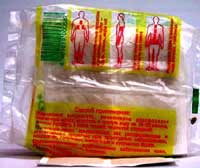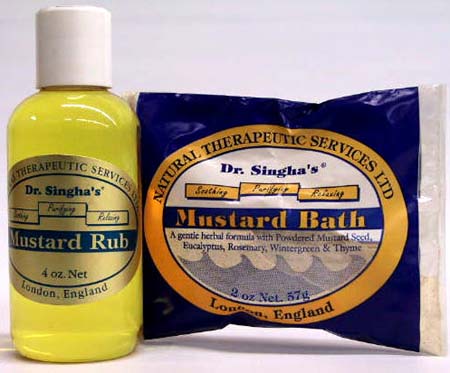Mustard has been used as medicine for centuries. Ancient manuscripts tell of mustard's use in treating pulmonary diseases, snake bites, and skin rashes. In more recent times, mustard's healing powers have been used to relieve the suffering of rheumatism, arthritis, sore throats, and even tooth aches.
In the days before aspirin and antibiotics, MUSTARD PLASTERS were commonly used throughout the world to treat a myriad of ailments. The plasters (also called POULTICES) were a mix of dry mustard and water applied onto a cloth. Through the well-established principle of counter-irritation, the plasters provided soothing heat and relief. Mustard plasters are still in use today in some parts of the world; note the mustard plaster in the Museum exhibit from Russia (a gift of Tatiana Smorodinskaya). Still being applied to ailing Muscovites in the 21st century.
 |
 |
| Front and back of Russian mustard plaster still in use today. |
Mustard compounds, such as MUSTARINE and MUSTEROLE bridged the gap between mustard plasters and the more modern ointments (such as Vicks' "Vap-o Rub"). They contained little mustard but their names gave confidence to consumers wary of giving up their traditional mustard remedies.
 |
| Mustarole and mustarine. |
 |
| U. S. Army mustard pot. |
The mustard pot in the Museum's display here was used by the United States Army medical corps to hold dry mustard for the preparation of mustard plasters.
 |
| Dr. Singha's Rub and Bath. |
The current trend in homeopathic remedies has brought a return of mustard to the healing arts. The Mustard Rub and Mustard Bath in the display are current products that provide welcome relief from aching muscles. (Both are available from the Mustard Museum on-line catalog; see Mustard Bath and Oil department).
Here is a "recipe" for a traditional mustard plaster, from a book published in 1880:
"Mix powdered mustard with water and a little vinegar to make a thin paste. Spread on brown paper with a piece of muslin over it. It should be kept on for from 5 to 20 minutes."
Be very careful in making your own mustard plaster; they can be very hot and even cause blisters!
|



